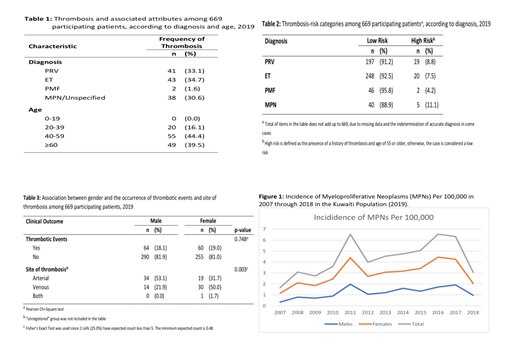Introduction
Myeloproliferative neoplasms (MPNs) are a group of hematopoietic disorders of stem-cell origin, characterized by mutations that disrupt hematopoietic signal-transduction pathways. The Middle East lacks an MPN registry representative of the disease in our area. Here we report on the epidemiology of these neoplasms in our area, including phenotype, clinical features and relevant outcomes.
Methods
This population-based study reports various demographic characteristics and clinical attributes of all suspected and confirmed MPN patients from all over Kuwait referred to the research hematology lab at Kuwait University & cytogenetic lab in Kuwait Cancer Control Centre (KCCC) during the period from 2007 to 2018. Molecular determination of the patients' driver mutation status currently relies on ARMS-PCR. Confirming a diagnosis follows the WHO criteria, and its refinements, for the diagnosis of MPNs. Data entry and analysis was performed using SPSS (v.22) software.
Results
Most patients are ≥ 40 years old (79.8%), with a median age of 55 years. Gender distribution is almost equal, with ethnic categorization as Kuwaiti and Non-Kuwaiti showing a similar pattern. ET is the most common diagnosis (40.1%), followed by PRV (32.3%). JAK2 V617F mutation is reported positive in 89.7% of cases, followed by CALR in 8.0% of MPNs. The incidence of MPNs ranged from 0.5 to 2.1 per 100,000 in 2007 through 2018. The lowest rate was recorded in 2007 (0.511) and the highest was observed in 2011 and 2016 (2.417 and 2.101, respectively). The increase in 2011 is likely due to the introduction of a more sensitive technique using ARMS-PCR for the diagnosis of MPNs, whereas the increase in 2017 may be explained by the publication of WHO 2016 modified criteria. Moreover, throughout the years, the distribution of MPNs in different age groups showed similar pattern, with the highest incidence in patients aged ≥ 60. Driver mutations can fit with a general increase in incidence from 2007-2017, which may be attributed to increased awareness among treating physicians asking suspected cases to screen for MPNs using molecular techniques.One hundred and twenty-four (18.5%) cases were documented to have a prior history of thrombosis, with roughly equal distribution between arterial and venous sites. A large proportion (89.5%) of the thrombotic events occurred in those who are ≥ 40 years old, with most events being associated with ET (34.7%) and PRV (33.1%). Almost one-third of cases of thrombosis were associated with undetermined MPN diagnosis. Participating patients were categorized as either low or high risk for thrombotic events, with the latter being defined as age ≥ 55 years and the presence of a previous thrombotic event. The results demonstrate that a total of 46 cases were defined as high risk, most of them being associated with ET (20 cases) and PRV (19 cases). A statistically significant association was reported between gender and site of occurrence of thrombotic events, with males having more arterial thromboses, and females were documented to have more venous thromboses.
Conclusion
JAK2 V617F driver mutation is the most common positive finding in the participating patients. Roughly one-fifth of the participants encountered thrombotic events, and the site of thrombosis is associated with gender, demonstrating statistical significance. These results should warrant a more thorough evaluation of MPNs in Kuwait to provide a better understanding of its epidemiology. This can be achieved through optimized documentation of patients' data, and testing for additional novel driver mutations and transformation; as well as encourage physicians in primary care centers to refer suspected cases for molecular diagnosis.
No relevant conflicts of interest to declare.
Author notes
Asterisk with author names denotes non-ASH members.


This feature is available to Subscribers Only
Sign In or Create an Account Close Modal